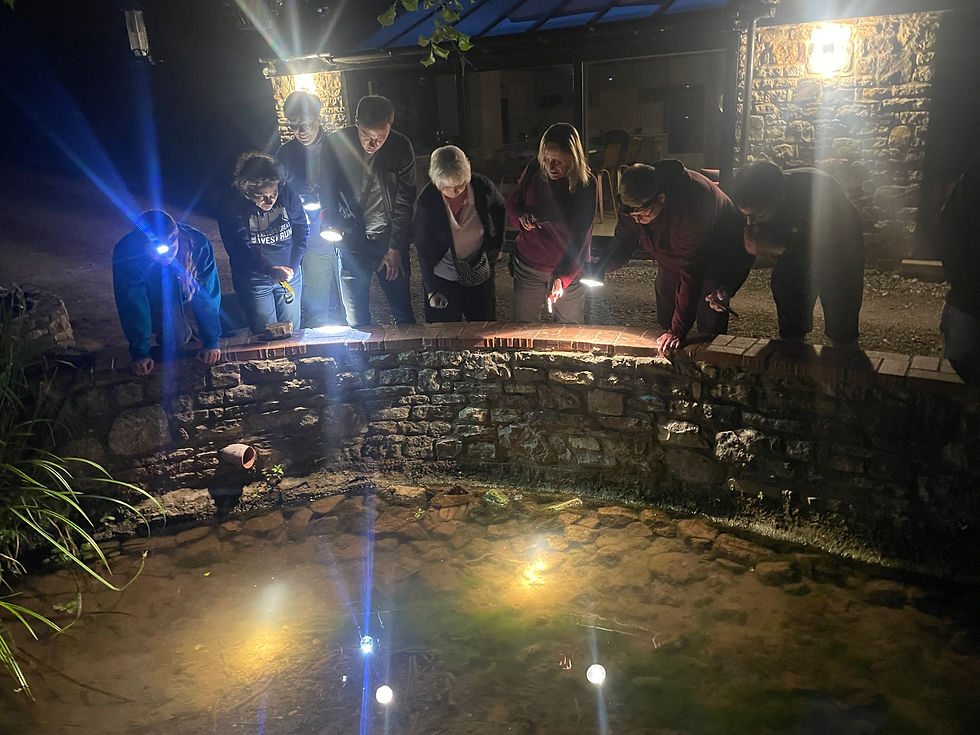July 2025
- piersclark7
- Aug 1
- 5 min read
This is a Bechstein bat. They are absolutely stunning. It is one of the UK’s rarest and most endangered bat species. We captured her during our July 18th Bat Survey night, under the guidance of licensed bat handler Martyn Cooke.
Bechstein’s can only be found in the South England (Wiltshire, Dorset, Devon typically) and in West Sussex we are right at the edge of their known range. Bechstein’s were recently in the news because a half mile £100m tunnel was proposed as part of the HS2 project to protect them. Our bat was captured at 1202am, literally 2 minutes after most of the people attending the evening had left (but they did get to see the Natterers Bat and the Pipistrelle bats)
Here is the Natterers Bat, so named after the Austrian naturalist Johann Natterer. The Natterer is distinguished by ‘its ‘S-shaped calcar, the strip of cartilage that runs along the side of the tail membrane, and the fine white hairs along the edge of the membrane’. Yet another reason for only doing bat surveys with a licensed bat handler!
Note we have future Bat Survey evenings on August 29th and Sept 26th – there are still some places available if you want to come along. No charge, just message me on piers.clark@aspectnaturereserve.com if interested. Suitable for all ages.
Martyn had put some static bat monitors in the woods prior to the survey and these identified another rare (Annex 2) species, the Barbastelle. My dream is we trap one of those during our two forthcoming survey nights.

In other news, the Environment Agency had been very helpful and have given us a definitive identification of our crayfish species. It isn’t a White Claw (our only UK native species), nor is it a Signal Crayfish (the aggressive, invasive US species that has decimated the White Claw populations since it was deliberately introduced - for commercial reasons - in the 1970s).
It isn’t even the Red Swamp Crayfish (or Louisiana Crawfish) as we thought a couple of months ago.
It is a White River Crayfish – a new invasive species.

I attended a 2 day Crayfish course in Wiltshire this month, getting ‘hands on’ with both Signal Crayfish and White Claw Crayfish (being very careful not to cross contaminate as the Signal crayfish carries a plague toxic to the White Claw). Seeing some rivers truly infested with Signal crayfish was both absorbing and heart-breaking.


After an 18 month planning permission process we were finally able this month to start construction of the pond and (in a completely separate project) the creation of an area of the wet/flooded woodland. Loads of work to do over the coming years to turn these currently rather ugly ‘construction sites’ into the desired habitats, but this is an important first step.
We have used the soil from the pond to create large banks around the western edge, which will be seeded with wildflowers. A bird-hide has been constructed within the bank, carefully positioned to ensure a full view of all sections of the pond, which will ultimately have zones of reeds, pebble and cobble ‘beaches’, rocky areas, and sunken wood habitats.
We are under the flight path and the good folk at Gatwick Airport have been incredibly helpful providing guidance to ensure the pond design will not attract bird species that could cause a bird-strike.
Wet/flooded woodland is a particularly useful, unique and infrequently found habitat across Britain. Creating a decent sized area of wet woodland has been a dream of mine since Richard Black, Sussex Wildlife Trust, told me they were the favoured habitat of Woodcocks. We had a brief sighting of a Woodcock last December in Mount Wood, and my hope is that with the creation of this new, much larger area we can entice them to stay longer.
Part of the reason for creating the wet woodland is to hold water on site for longer periods.
During July we had two separate days when local businesses visited to undertake a combination of team building exercises and games, and ecological activities.
If you are interested in organising a corporate visit to Aspect Nature Reserve let me know. We can provide an exciting day of team building activities (and games) with an important ecology and conservation angle. Here are a couple of quotes from our visitors this month:
'It's so rewarding to do hands-on conservation work with colleagues, getting your hands dirty together and making a real difference to this special part of the countryside. Fresh air, meaningful work and shared achievement is a great recipe' - Tom J
"We had a great day at Aspect Nature Preserve! I loved learning about and getting the chance to be part of such an exciting project, plus it was great to get some dirt under our nails and bond as a team. Getting outside of the office and working on something completely new with colleagues was such a great way to forget for a moment about our day-to-day, enjoy the change of scenery, give back to our environment and community, and tune into each other on a new level." - Lara A
"It was a perfect opportunity to connect outside the office and enjoy some quality time in nature." - Beatriz A

See you next month, Please like and share as appropriate.










Comments